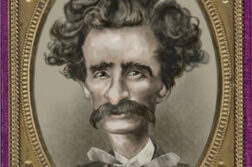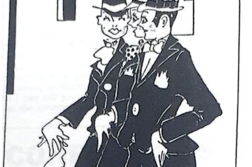Editor’s Note: “Stonewall” has become one of those iconic events in history, like the storming of the Bastille or the bombing of Pearl Harbor, whose significance has little to do with the “facts on the ground,” as today’s journalists might call them. And while no one disputes the role of Stonewall as the symbolic start of the gay liberation movement, the event we still celebrate every year in June, the facts themselves are very much in dispute. Who actually began the riot in the Stonewall Inn one hot summer night in 1969, a bevy of angry drag queens or a stable of frisky young men? And what sustained the rioting for several days thereafter, a spontaneous outpouring from the community or serious political organizing behind the scenes? The following essay tries to address these questions by presenting without fear or favor the facts as they are known.
There’s also the question of why it was the Stonewall uprising that acquired this singular role in GLBT history, considering that similar events had occurred in San Francisco and Los Angeles (as Belinda Baldwin documents in this issue), and the earliest organizing also took place on the West Coast, where the two main gay rights organizations, the Mattachine Society and the Daughters of Bilitis, were born. The following account offers a straightforward hypothesis. As it happens, the author was on the New York scene and sensed the importance of unfolding events, so he saved some of the posters and buttons and pamphlets that came out soon after the rioting. What they reveal is that there was a massive effort to mobilize gay men and lesbians through political organizing and community building, which is widely acknowledged as the key to Stonewall’s success. But they also reveal that there was a consciousness of Stonewall as a signal event early on, and a concerted attempt to establish “Stonewall” as a symbolic turning point. There was even a debate over what to call the events of late June, which were being called the “Christopher Street Riots”; “Stonewall” was decided upon to avoid associating America’s gayest street with rioting.
Thus also began Toby Marotta’s career as an archivist. In addition to the following account, he has been kind enough to supply a number of illustrations that appear on the cover and accompany this article. Additional materials can be viewed on his website at www.RootsArchive.com.
 IN THE WEE HOURS of Saturday, June 28, 1969, a team of plainclothes police detectives raided the Stonewall Inn. “The Stonewall” was a gay bar located close to where Christopher Street meets Seventh Avenue in Greenwich Village. Across the street from it stood a roughly triangular sliver of land named Christopher Park. This sparely landscaped, fenced-in oasis was an island in the storm of cross-cutting streets, sidewalks, subway entrances, and bus stops that kept Sheridan Square busy day and night.
IN THE WEE HOURS of Saturday, June 28, 1969, a team of plainclothes police detectives raided the Stonewall Inn. “The Stonewall” was a gay bar located close to where Christopher Street meets Seventh Avenue in Greenwich Village. Across the street from it stood a roughly triangular sliver of land named Christopher Park. This sparely landscaped, fenced-in oasis was an island in the storm of cross-cutting streets, sidewalks, subway entrances, and bus stops that kept Sheridan Square busy day and night.
 On the night of this June 28th bar raid—the most recent of several such incidents at the Stonewall Inn and other gay haunts in “the Village”—authorities followed their standard procedures. First they released bar patrons able to show the proof of legal age they were required to carry. Then they escorted the apprehended bar employees and men presumed to be dressing as women to police vans waiting in the street to transport them to the Sixth Precinct police station. Here these cross-dressers would be examined to verify that they were men, and all designated law-breakers would be booked and arrested.
On the night of this June 28th bar raid—the most recent of several such incidents at the Stonewall Inn and other gay haunts in “the Village”—authorities followed their standard procedures. First they released bar patrons able to show the proof of legal age they were required to carry. Then they escorted the apprehended bar employees and men presumed to be dressing as women to police vans waiting in the street to transport them to the Sixth Precinct police station. Here these cross-dressers would be examined to verify that they were men, and all designated law-breakers would be booked and arrested.
This night, however, most of the dislocated patrons had refrained from fleeing into the night. Instead, they were loitering on the sidewalk alongside the park, watching the rest of the proceedings unfold. When some of the presumed cross-dressers tangled with the officers who were escorting them to the curb, members of this impromptu audience broke another precedent by shouting encouragement. When someone managed to jump out of a van and run off, they cheered. Passersby attracted by the commotion joined in.
Led by a few precocious activists, several of these observers began to taunt the police. Soon they were pelting them with coins, rocks, bottles, and bricks. When the stunned detectives retreated into the bar, the result outside was surprise and delight, followed by a surging sense of power at having challenged and intimidated long-feared authority figures. Emboldened protestors now swarmed across the street, crowded onto the sidewalk in front of the Stonewall, and bashed in its windows and doors.
Police reports recorded this episode as a “riot” that lasted for forty minutes. Officially it ended when a summoned squad of riot-control police succeeded in clearing the stretch of Christopher Street in front of the bar. Despite erected barricades and posted patrolmen, however, agitated and awestruck spectators milled around in Sheridan Square, the bulk of which lies on the far side of Christopher Park, until daybreak.
As far back as the 1920’s, Greenwich Village had been known as a bohemian enclave whose residents included prominent homosexual artists and intellectuals. By 1969, so many of the district’s residents and visitors were gay, and so many of its commercial establishments gay-oriented, that the Village effectively functioned as a gay ghetto. Yet even as gays grew more comfortable in this neighborhood, it was customary for them to play it safe and act straight when in public, avoiding physical contact. Few of those who now descended upon Sheridan Square had ever before bared their homosexual feelings outside private or anonymous settings.
All day Saturday, as word spread about the previous night’s rioting, their numbers continued to grow. Gay visitors examined the battered façade and boarded-up windows and doors of the Stonewall Inn. They gathered across the street in and around Christopher Park to gossip, share impressions, and speculate on what might happen next. By the afternoon, the Stonewall had reopened as a juice bar. Its employees were handing out balloons. Its owners, well into their third year of profitable operation, were blaming the police for the raid. But already they, too, had been put on notice that there was a new force in town—what the eye-catching graffiti chalked onto their storefront called “Gay Power” and “Queer Power.” 
As evening arrived, friends greeted one another and even newly identified acquaintances with shameless hugs. Improvised wisecracking, singing, and dancing gave rise to more choreographed cheers, chants, and kick lines. For the first time, in-group slang, campy performance, unspoken lusts, and even long-suppressed resentments were being aired—all this in an officially patrolled public place.
As midnight came and went, more and more bar hoppers joined these lingering festivities. Soon partisans of every openly GLBT stripe had engulfed the entire eastern end of Christopher Street, extending from Seventh Avenue down two long blocks to where Greenwich Avenue meets Sixth Avenue, commonly known as the Avenue of the Americas. Now this row of charming apartment houses and arty shops was closed to traffic.
Once again, siren-screeching, light-flashing vans emptied squads of riot-control police into Sheridan Square. Wedges of these masked, shield-carrying, baton-and-teargas-wielding officers worked to clear the occupied stretch in front of the Stonewall. Others used the same strong-arm tactics to drive hordes of jubilant people from the corner of Greenwich and Sixth Avenue. But here, too, their efforts to herd revelers and stymie their high jinks created a manic mix of challenge, defiance, evasion, and escape. As on the night before, these street-clearing efforts spurred scores of agitated rioters to escape into accessible side streets and circle back via other entrances to Sheridan Square.
This second night of rioting was both more antic and more purposeful than the spontaneous outburst of the night before. It was accompanied by more tangles between officers and gay people. It resulted in more violence and greater bloodshed. And it led to incidents of individual and organized acting-out that filtered into the surrounding neighborhood and continued until the dawn of Sunday, June 29.
A heavy police presence kept agitators in check for the remainder of Sunday. Rain discouraged visitors from congregating in Sheridan Square on Monday and Tuesday evenings. But on Wednesday, July 2, after dark, the bloodiest and most destructive rioting of all flared up on this easternmost stretch of Christopher Street. At one point there were blazing fires in all of the steel trash containers that lined its sidewalks.
THIS WHOLE WAVE of disruption, from the three nights of street demonstrations to the countless acts of resistance and defiance by these characters and cliques, would soon be dubbed the Stonewall Riots. It started as a disorganized rebellion against oppression, but it triggered a chain reaction of community-building and political organizing that was emulated across the country and publicized throughout the world. Overnight this unprecedented surge of organizing transformed what had been a largely underground vanguard movement into a highly public mass movement for gay pride, power, and community.
Exactly one year later, at the end of June in 1970, representatives of these newly organized and mobilized subgroups came together to commemorate the Stonewall Riots with a week of what were dubbed Pride Events. Their climactic Sunday march and “Gay-In” were billed as the “First Birthday of Gay Liberation.” And the designation stuck: we still celebrate Gay Pride in June and count the years since Stonewall. In just one year these activists and community builders had founded new organizations, notably the Gay Liberation Front and the Gay Activists Alliance, radical groups by today’s standards but the start of an institutionalized national GLBT rights movement.
For all the drama of the riots themselves, it’s clear that the significance of “Stonewall” lies in what the riots immediately precipitated in the summer of 1969: an unprecedented surge of activism and organizing for gay and lesbian rights. They empowered a new generation of activists and engendered a whole new approach to gay and lesbian politics.
The first night of rioting in front of the Stonewall Inn is still mythologized in much the same way that the French have mythologized the storming of the Bastille in 1789—an incident to which it is often compared. To be sure, there had been similar riots in other cities, notably San Francisco and Los Angeles, going back to the mid-1960’s, so this style of “rebellion” was already out there in the popular consciousness. What differed in New York was not the spontaneity of the first night but the increasingly organized efforts that followed on successive nights—and above all the more sober organizing that followed once the riots had ended.
Toby Marotta is the author of three early gay ethnographies, including 1982’s Sons of Harvard: Gay men from the class of 1967. His archive of the post-Stonewall era can be found at www.RootsArchive.com.





